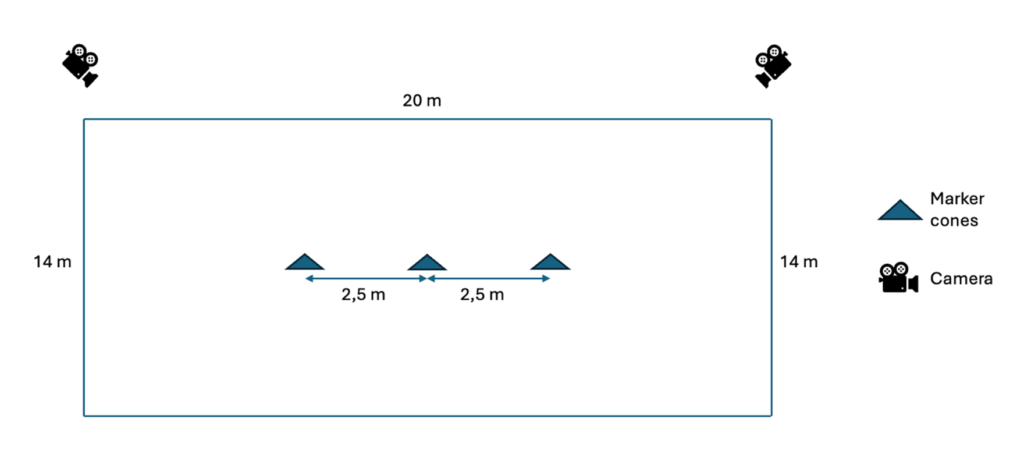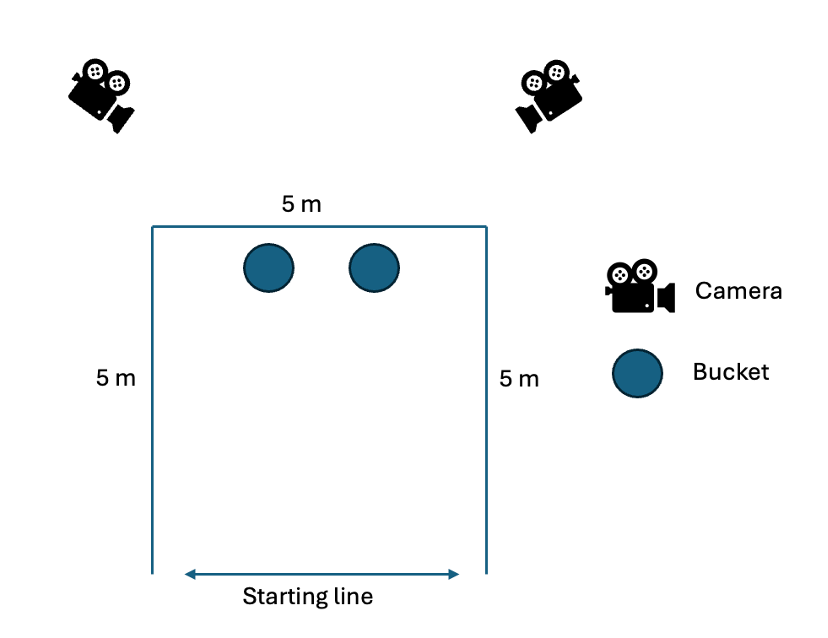This study included 30 participating owners with their horses from six different stables around Linköping, Sweden. Two different tests were used to investigate if the horses preferred their owner over a stranger.
Separation-reunion test
The test was conducted in a test arena (Fig. 1) built in an indoor riding arena. The test was recorded for later analysis.

Figure 1: Experimental arena for the separation-reunion test.
The horse was first left alone in the test arena for one minute while the owner and the experimenter, also serving as stranger during the test, left the indoor riding arena altogether. During the one-minute separation the horse was given a stress score on a scale from 1-3, one representing the least stressed horses and three representing the very stressed horses.
After one minute the owner and a stranger entered the test arena and placed themselves at the marker cone furthest to the right and to the left. The reunion phase of the test lasted three minutes during which the owner and stranger stood passively at the marker cones without acknowledging the horse.
When analyzing the video of the reunion-phase I looked at three contact-seeking behaviors:
- Body length proximity – the horse was one horse length away from either owner or stranger
- Head proximity – the horse was one horse-head length away from either owner or stranger
- Physical contact – the horse was in physical contact with either owner or stranger
Statistical analysis
A Wilcoxon rank sum test was used to determine if there was a significant difference in the horses’ body length proximity, head proximity or physical contact towards the owner and the stranger.
General linear models (GLMs) were used to determine if stress and type of horse (full-size horse, Icelandic horse, pony) had a significant effect on the behaviors towards either the owner or the stranger.
Odor preference test
The test was conducted in a test arena (Fig. 2) built in an indoor riding arena. The test was recorded for later analysis. Prior to the test the participants were instructed to wear a new t-shirt for five nights in a row and shower with a neutral soap. The t-shirts were then collected and cut in half so that people from one stable could act as strangers to horses in another stable.

Figure 2: Experimental arena for the odor preference test.
Prior to the odor preference test the horse was trained to approach a bucket with carrot pieces in it. The odor preference test could be conducted once the horse could start at the starting line and approach the bucket on its own. During the test two buckets were placed at the end of the test arena. One bucket contained the t-shirt with the owner’s odor on it and the other contained a t-shirt with a stranger’s odor on it. The test lasted three minutes.
When analyzing the video of the odor preference test I looked at two contact-seeking behaviors:
- Muzzle proximity – the horse’s muzzle was half a horse-head length away from either of the buckets
- Physical contact – any part of the horse was in physical contact with either of the buckets
Statistical analysis
A Wilcoxon rank sum test was used to determine if there was a significant difference in the horses’ muzzle proximity or physical contact towards the bucket containing the owner’s odor and the bucket containing the stranger’s odor.
General linear models (GLMs) were used to determine if type of horse (full-size horse, Icelandic horse, pony) had a significant effect on the behaviors towards either the owner or the stranger.